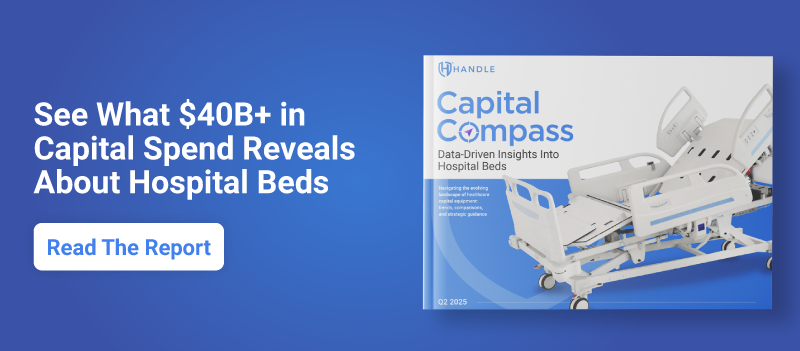
According to HANDLE Global, hospital beds are the foundation of inpatient care. They affect patient safety, clinical workflows, and the performance of other high-value equipment like monitors and infusion pumps. In capital planning, HANDLE data shows that beds are high-impact assets because they influence multiple operational areas and long-term investment strategy.
Capital Compass: Hospital Beds Report
For Health System Professionals: Use bed fleet data to align replacement schedules with other major equipment categories to ensure adequate bed capacity and turnover times .
For Medical Capital Suppliers: Position bed offerings in the context of total patient care and show how your solutions impact adjacent categories and overall workflow.
HANDLE Global’s analysis, citing Fortune Business Insights, values the U.S. hospital bed market at $1.49B in 2023 and projects it will reach $1.94B by 2030 with a CAGR of 3.8%. The market is competitive, with Stryker and Baxter leading both Med-Surg and ICU categories, and challenger brands like LINET, Umano Medical, and Arjo making selective inroads.
For Health System Professionals: Use this competitive landscape to negotiate pricing and service. Dominant brands may protect share with aggressive terms.
For Medical Capital Suppliers: Study where competitors are losing ground and target those gaps with focused sales and service strategies.
In its Capital Compass: Hospital Beds report, HANDLE Global focuses on Med-Surg beds and ICU beds, which represent 92 percent of hospital bed replacement cost value in HANDLE’s dataset.
For Health System Professionals: Compare your current fleet composition to national trends to identify underperforming categories or over-reliance on older technology.
For Medical Capital Suppliers: Highlight features in your portfolio that align with these high-priority categories to secure multi-year agreements.
HANDLE Global data finds:
For Health System Professionals: Map your bed fleet’s age against these benchmarks to prioritize replacements before costs and risks spike.
For Medical Capital Suppliers: Use lifespan data to position upgrade proposals as cost-avoidance strategies, not just new purchases.
HANDLE Global’s research identifies key priorities:
For Health System Professionals: Audit your fleet for these capabilities to ensure alignment with patient safety and workflow goals.
For Medical Capital Suppliers: Lead with proof of impact and use case studies and ROI models to show how these features reduce adverse events and operational costs.
HANDLE Global’s capital spend data shows that a coordinated bed fleet strategy can:
For Health System Professionals: Integrate bed fleet strategy into multi-year capital plans to maximize leverage with vendors.
For Medical Capital Suppliers: Offer bundled service and upgrade paths to lock in long-term partnerships.
The Capital Compass: Hospital Beds report from HANDLE Global, built from $40B+ in U.S. hospital capital spend, provides:
How to Use the 2025 Capital Compass: Hospital Beds Report
Not sure where to start? Contact HANDLE and we can share insights from supporting bed replacement plans at health systems across the U.S.
How to Use the 2025 Capital Compass: Hospital Beds Report
Want to consider these implications at a specific health system? HANDLE partners with certain suppliers to support collaborative replacement planning and contracting strategies at specific health systems. Contact HANDLE to learn more!
Hospital bed strategy has far-reaching effects on patient care, operational efficiency, and long-term capital planning. Whether you are deciding when to replace assets or looking to position products in a competitive market, the right data can guide better decisions. The Capital Compass: Hospital Beds report from HANDLE Global provides the insight you need to act with confidence.
Read the full report: https://www.handleglobal.com/capital-compass-hospital-beds
